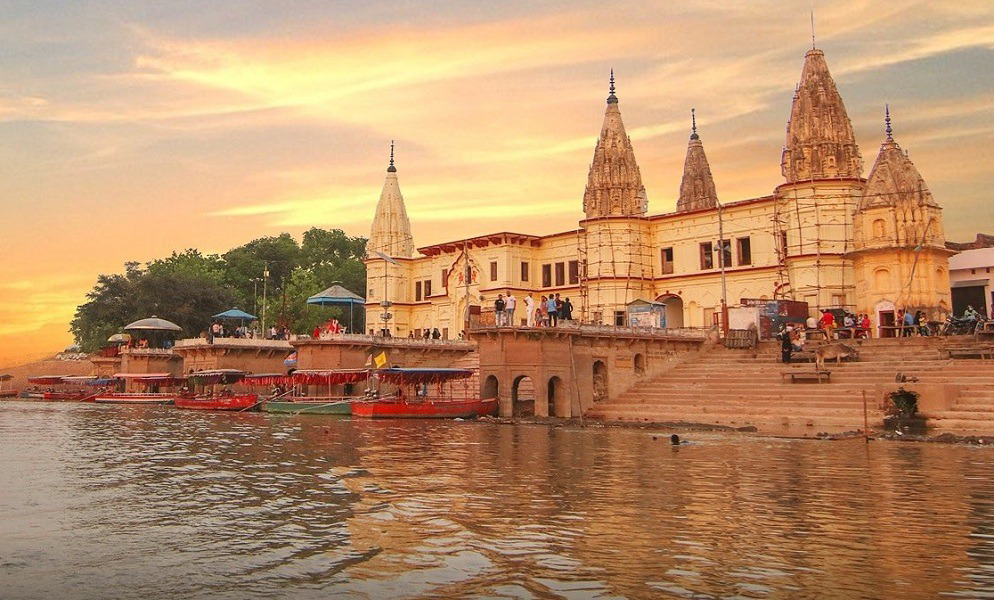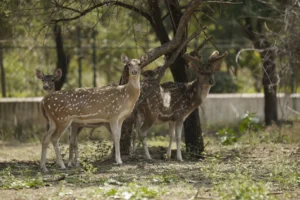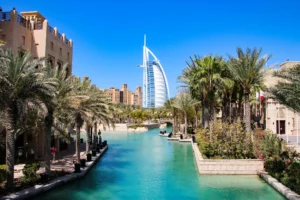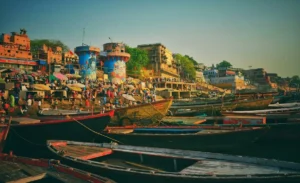Introduction:
Nestled along the banks of the sacred Sarayu River, Ayodhya stands as a city woven with threads of history, mythology, and spirituality. In this expansive guide, we will embark on a journey through the heart of Ayodhya, unraveling the tales and exploring the architectural gems that make this city a captivating destination for pilgrims and history enthusiasts alike. Join us as we look into the details of 20 must-visit tourist places, each contributing to the vibrant mosaic that is Ayodhya.
- Ram Janmabhoomi:
At the epicenter of Ayodhya’s spiritual landscape lies Ram Janmabhoomi, the revered birthplace of Lord Rama. The Ram Temple, a symbol of devotion and architectural grandeur, beckons visitors to witness history in the making. City connectivity is facilitated by well-maintained roads, making it accessible for pilgrims and tourists alike. Allocate a generous 2-3 hours to explore the complex, allowing time for contemplation and marveling at the intricate carvings that adorn the temple walls.
- Hanuman Garhi:
Perched atop a hillock, Hanuman Garhi commands panoramic views of Ayodhya. The temple, dedicated to Lord Hanuman, stands as a sentinel of devotion and strength. Connected by local transport, devotees can easily access this sacred site. Spend a contemplative 1-2 hours exploring the temple complex, participate in the evening aarti, and climb the steep stairs for a breathtaking view of the city.
- Kanak Bhavan:
In the heart of Ayodhya, Kanak Bhavan stands as a testament to the opulence associated with Lord Rama’s kingdom. The palace, adorned with beautiful frescoes and intricate carvings, offers a glimpse into the grandeur of the Treta Yuga. Easily reachable, devote 1-2 hours to immerse yourself in the tales depicted on the palace walls, and marvel at the architectural finesse that defines Kanak Bhavan.
- Treta Ke Thakur:
Situated near the tranquil banks of the Saryu River, Treta Ke Thakur is a revered spot where deities from the Treta Yuga are worshiped. The connectivity is seamless, providing a serene ambiance for devotees. A quick visit of 30 minutes is sufficient to absorb the spiritual energy, take a peaceful stroll along the riverbank, and reflect on the historical significance of this sacred site.
- Nageshwarnath Temple:
Nestled near Hanuman Garhi, the Nageshwarnath Temple is dedicated to Lord Shiva and is a serene place for prayer and introspection. Well-connected, devote at least 1-2 hours to explore the temple complex, participate in the evening aarti, and take a leisurely stroll along the nearby ghats.
- Bharat Kund:
Located near Ram Janmabhoomi, Bharat Kund is a historic step well that resonates with tales from the Ramayana. The connectivity is excellent, allowing visitors to easily include it in their itinerary. Spend an hour unraveling the history of this sacred stepwell, capturing the intricacies of its architecture, and reflecting on its significance in the epic narrative.
- Shri Raja Mandir:
Centrally located, Shri Raja Mandir is an architectural marvel dedicated to Lord Rama. Easily accessible, allocate 1-2 hours to explore the ancient temple, marvel at its intricate carvings, and immerse yourself in the daily rituals that add to the spiritual aura of this sacred space.
- Guptar Ghat:
Along the serene banks of the Saryu River, Guptar Ghat invites visitors to experience tranquility. Connectivity is facilitated by road, providing an ideal setting for a peaceful evening by the river. Spend 1-2 hours at the ghat, enjoy a boat ride, and witness the colors of the spectacular sunset painting the sky over Ayodhya.
- Tulsi Smarak Bhawan:
Adjacent to Kanak Bhavan, Tulsi Smarak Bhawan stands as a tribute to the great Saint Tulsidas. Well-connected, plan 2-3 hours to explore the museum, peruse the exhibits, and delve into the life and teachings of this revered saint. The attached library provides a serene space for those inclined towards literary pursuits.
- Moti Mahal:
Centrally located, Moti Mahal is a historical palace with architectural finesse. Easily accessible, allocate 1-2 hours to explore the intricacies of this regal structure, marvel at its architectural details, and capture panoramic views from its terrace, offering a glimpse into Ayodhya’s storied past.
- Ramkatha Park:
Adjacent to Ram Janmabhoomi, Ramkatha Park is a lush expanse offering a tranquil escape. Centrally located, plan 2-3 hours for a leisurely stroll through the park, enjoying its landscaped gardens and perhaps partaking in any cultural events that may be scheduled, offering a deeper insight into the cultural tapestry of Ayodhya.
- Lakshman Ghat:
Situated along the banks of the Saryu River, Lakshman Ghat provides a serene setting for spiritual seekers. Accessible by road, spend a contemplative 1-2 hours at the ghat, taking a holy dip in the river and soaking in the spiritual ambiance that resonates with the tales of the Ramayana.
- Ram Ki Paidi:
Centrally located, Ram Ki Paidi is a series of ghats offering a mesmerizing spectacle during the evening aarti. Easily accessible, spend a peaceful 1-2 hours attending the aarti, reveling in the illuminated ghats, and soaking in the spiritual energy that permeates this sacred space.
- Sita Ki Rasoi:
Near Ram Janmabhoomi, Sita Ki Rasoi is an ancient kitchen associated with Sita, the consort of Lord Rama. Well-connected, plan 1-2 hours to explore this historical site, marvel at the intricate carvings that adorn the kitchen, and reflect on the symbolism embedded in this sacred space.
- Gulab Bari:
In the heart of Ayodhya, Gulab Bari is a historical garden reflecting Mughal influences. Easily accessible, allocate 1-2 hours for a leisurely walk through the garden, admiring the Mughal architecture, and capturing the essence of a bygone era in this enchanting oasis.
- Kusha Ghat:
Along the banks of the Saryu River, Kusha Ghat offers a serene retreat. Accessible by road, spend a peaceful 1-2 hours, enjoying a boat ride on the river, witnessing the spectacular sunset that paints the sky, and immersing yourself in the tranquil ambiance of this riverside location.
- Bahu Begum Ka Maqbara:
Near Hanuman Garhi, Bahu Begum Ka Maqbara is a historic mausoleum with Indo-Saracenic architecture. Well-connected, allocate 1-2 hours to explore the mausoleum, appreciate the architectural nuances, and delve into the history that surrounds this regal resting place.
- Kanak Bhavan:
In the heart of Ayodhya, Kanak Bhavan stands as a testament to the opulence associated with Lord Rama’s kingdom. The palace, adorned with beautiful frescoes and intricate carvings, offers a glimpse into the grandeur of the Treta Yuga. Easily reachable, devote 1-2 hours to immerse yourself in the tales depicted on the palace walls, and marvel at the architectural finesse that defines Kanak Bhavan.
- Treta Ke Thakur:
Situated near the tranquil banks of the Saryu River, Treta Ke Thakur is a revered spot where deities from the Treta Yuga are worshiped. The connectivity is seamless, providing a serene ambiance for devotees. A quick visit of 30 minutes is sufficient to absorb the spiritual energy, take a peaceful stroll along the riverbank, and reflect on the historical significance of this sacred site.
- Nageshwarnath Temple:
Nestled near Hanuman Garhi, the Nageshwarnath Temple is dedicated to Lord Shiva and is a serene place for prayer and introspection. Well-connected, devote at least 1-2 hours to explore the temple complex, participate in the evening aarti, and take a leisurely stroll along the nearby ghats.
- Bharat Kund:
Located near Ram Janmabhoomi, Bharat Kund is a historic stepwell that resonates with tales from the Ramayana. The connectivity is excellent, allowing visitors to easily include it in their itinerary. Spend an hour unraveling the history of this sacred stepwell, capturing the intricacies of its architecture, and reflecting on its significance in the epic narrative.
- Shri Raja Mandir:
Centrally located, Shri Raja Mandir is an architectural marvel dedicated to Lord Rama. Easily accessible, allocate 1-2 hours to explore the ancient temple, marvel at its intricate carvings, and immerse yourself in the daily rituals that add to the spiritual aura of this sacred space.
- Guptar Ghat:
Along the serene banks of the Saryu River, Guptar Ghat invites visitors to experience tranquility. Connectivity is facilitated by road, providing an ideal setting for a peaceful evening by the river. Spend 1-2 hours at the ghat, enjoy a boat ride, and witness the colors of the spectacular sunset painting the sky over Ayodhya.
- Tulsi Smarak Bhawan:
Adjacent to Kanak Bhavan, Tulsi Smarak Bhawan stands as a tribute to the great Saint Tulsidas. Well-connected, plan 2-3 hours to explore the museum, peruse the exhibits, and delve into the life and teachings of this revered saint. The attached library provides a serene space for those inclined towards literary pursuits.
- Moti Mahal:
Centrally located, Moti Mahal is a historical palace with architectural finesse. Easily accessible, allocate 1-2 hours to explore the intricacies of this regal structure, marvel at its architectural details, and capture panoramic views from its terrace, offering a glimpse into Ayodhya’s storied past.
- Ramkatha Park:
Adjacent to Ram Janmabhoomi, Ramkatha Park is a lush expanse offering a tranquil escape. Centrally located, plan 2-3 hours for a leisurely stroll through the park, enjoying its landscaped gardens and perhaps partaking in any cultural events that may be scheduled, offering a deeper insight into the cultural tapestry of Ayodhya.
- Lakshman Ghat:
Situated along the banks of the Saryu River, Lakshman Ghat provides a serene setting for spiritual seekers. Accessible by road, spend a contemplative 1-2 hours at the ghat, taking a holy dip in the river and soaking in the spiritual ambiance that resonates with the tales of the Ramayana.
How to travel to Ayodhya?
Traveling to Ayodhya from major Indian cities is a seamless experience, with well-connected transportation options. Here’s a brief guide on how to reach Ayodhya from some prominent cities:
- Delhi to Ayodhya:
By Train: Board a train from New Delhi Railway Station to Faizabad Junction, the nearest railhead to Ayodhya. The journey takes approximately 10-12 hours.
By Road: Take a bus or hire a taxi for the 600 km road journey via NH 44. The travel time by road is around 12 hours.
- Mumbai to Ayodhya:
By Train: Opt for a train journey from Mumbai to Faizabad Junction, requiring approximately 24-28 hours.
By Air: Fly to Lucknow, the nearest airport to Ayodhya, and then take a taxi or bus for the 150 km journey. The total travel time is approximately 4-5 hours.
- Kolkata to Ayodhya:
By Train: Board a train from Howrah Junction to Ayodhya, with travel times ranging from 16-20 hours.
By Air: Fly to Lucknow, followed by a taxi or bus journey to Ayodhya. The total travel time is approximately 5-6 hours.
- Chennai to Ayodhya:
By Train: Choose a train from Chennai Central to Faizabad Junction, with travel times ranging from 36-40 hours.
By Air: Fly to Lucknow and then take a taxi or bus for the 150 km journey to Ayodhya. The total travel time is approximately 7-8 hours.
- Bengaluru to Ayodhya:
By Train: Opt for a train journey from Bengaluru to Faizabad Junction, taking approximately 36-40 hours.
By Air: Fly to Lucknow and then proceed to Ayodhya by taxi or bus. The total travel time is approximately 8-9 hours.
Remember to check the availability and schedules of trains or flights and plan your journey accordingly. Ayodhya’s well-connected railway station and proximity to major highways make it accessible, ensuring a smooth and memorable travel experience for pilgrims and tourists alike.
Conclusion:
As we conclude our exploration of Ayodhya’s vibrant tapestry, each of the 20 tourist places unravels a unique facet of this ancient city’s cultural and spiritual legacy. Ayodhya, with its temples, ghats, palaces, and parks, offers a holistic experience that transcends time. It invites travelers to connect with the divine, relive the tales of mythology, and witness the architectural splendors that stand as testaments to the city’s rich history. May your journey through Ayodhya be one of spiritual awakening and cultural immersion.







